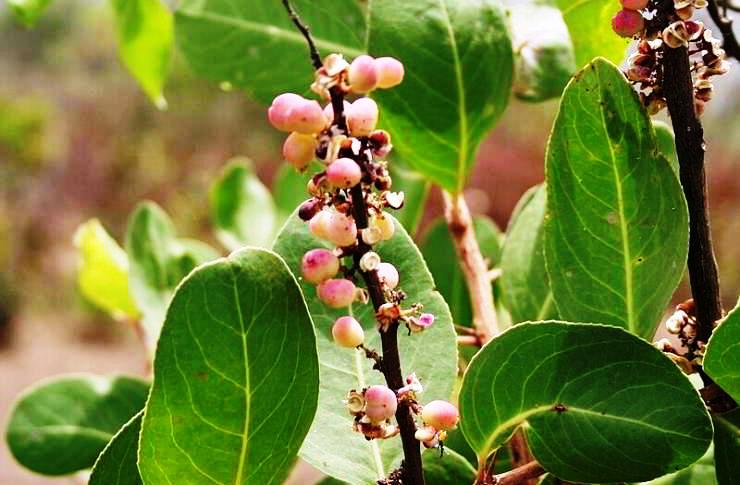It is used for the treatment of a number of diseases and disorders. In African traditional medicine, it is one of the oldest and dates back many generations.
Maytenus senegalensis (Lam.) Excell: it is commonly called Staff tree and belongs to the plant family Celastraceae. It is a shrub or a tree growing up to a height of 15m. Young branches are often spiny. Leaves are petiolate and alternate, usually glaucous, and coriaceous with pale green lamina. The flowers are dioecious, small in axillary, dichotomous or fasciculate cymes on short branchlets, often forming terminal, elongated panicles.
Geographically, Maytenus senegalensis has a wide distribution range, covering North Africa, Somalia to Senegal, South to South Africa, and including Madagascar. The plant is also found growing in Afghanistan and India. It grows within wide altitude ranges from 400–2,400m. The plant is widespread in the Savannah regions of tropical Africa occupying a wide variety of habitats, from deciduous woodland, thickets, shrub and wooded grassland, on river banks, and swamp margins.
Maytenus senegalensis is known in different dialects in Africa. For example, in South Africa the plant is called ubuhlangwe; in Tanzania, the Haya ethnic group refer to it as mweza while in Uganda, the Sebei and Baganda tribes call it munyandetap chemetyo and muwaiswa respectively. In the republic of Guinea, the plant is commonly referred to as gbee.
The use of Maytenus senegalensis in African traditional medicine is one of the oldest and dates back many generations. The indigenous people across many communities have always found solace in the medicinal values of this magical plant to treat and manage different health conditions.
Just like the case with most medicinal plants, the time/season of harvest for the effective medicinal value of this plant depends on which part the healer is interested in. For example, Maytenus senegalensis roots and stem bark are generally harvested during the dry season, while the leaves are usually harvested during the rainy season and then preserved in a typical traditional way, especially through drying.
Generally, the Maytenus senegalensis plant is traditionally used in folk medicine for the treatment of several diseases and disorders including arthritis, rheumatism, skin tumour, influenza, arthritis, bronchitis, diarrhoea, dysentery, gastrointestinal diseases, haemorrhoids, impotence, inflammation, menstrual disorders, nausea, osteoarthritis, pain, rheumatism, tumours, virility, eye infections, nausea, snakebites, severe headache, and also as an aphrodisiac.
Different plant parts, including leaves, roots, and stems, are used in the treatment of these diseases. For example, the leaf infusion/decoction of Maytenus senegalensis is used for the treatment of malaria, yellow fever, and tryanosomiasis. It is also used to treat and manage fertility problems, venereal diseases, pneumonia, epilepsy, as a tonic, and toothaches, as well as eye infections. Additionally, the leaf powder/decoction is orally administered by traditional healers to treat typhoid and hernia conditions. Bathing with the leaf infusion or taking it orally is recommended for relieving convulsion.
Stem bark decoction is administered orally or applied topically as an anti-inflammatory and analgesic remedy. The decoction is also used to treat haemorrhoids and male sterility, as well as being administered as an aphrodisiac for the loss of libido in males. In the same manner, the bark infusion is administered to tone, balance, and strengthen female hormonal systems, and in treating libido loss, menstrual pain and cramps. The freshly harvested green leaves are used as a poultice for skin sores.
In some pastoral communities, the root powder of Maytenus senegalensis is added to milk and meat-based foods or products. This, according to studies, has resulted in low incidences of cardiovascular diseases among these communities even though their daily diet contains high levels of fats and cholesterol.
In Central Africa, just as with the stem bark, the root powder is added to beer and taken as an aphrodisiac. The root infusion/decoction is used as a laxative and for the treatment of gastrointestinal troubles, especially dysentery. The root infusion is also administered to treat parasitic Schistosoma mansoni or worm infestation.
Furthermore, the root bark decoction is used in the treatment of chest pains, rheumatism, snakebites, diarrhoea, fever, epilepsy, sickle cell, abscess, stomach ache, malaria, uterine fibroids, chronic endometritis, headache, anaemia, syphilis as well as sterility in both males and females. The root powder is added to tea and taken to promote labour during birth. In addition, the root powder is also added to local brew and drunk to treat pyomyositis. The patients with migraine conditions chew the root bark of Maytenus senegalensis to extract the sap, which is vital in the treatment and management of the disease.
The wide spectrum of uses of the Maytenus senegalensis plant in African traditional medicine for the treatment of multiple diseases is attributed to the phytochemical contents in it, such as tannins, saponins, alkaloids and terpenoids. Scientific studies associate the presence of the quinone methide triterpenes compound in the plant to its malaria treatment activity.
Scientific studies have also proven that Maytenus senegalensis is a unique anti-inflammatory plant due to the presence of maytenoic acid. Consequently, the roots could potentially be employed in therapeutic preparations for the treatment of inflammation-based diseases. (Komakech Richard and Omujal Francis) – (Photo: CC BY-SA 2.5/Marco Schmidt)







